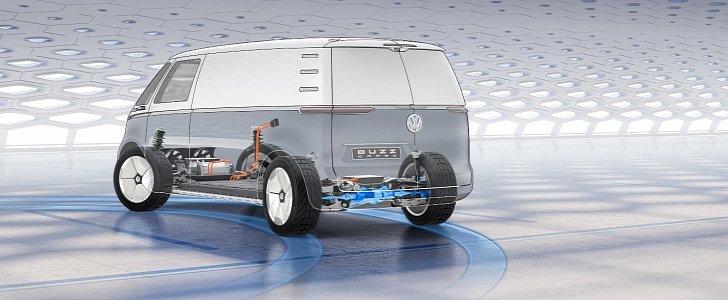Taking inspiration from the I.D. Buzz Concept, the Cargo promises 340 miles of range on the Worldwide Harmonized Light Vehicle Test Procedure. The electric panel van will be revealed in the flesh at the 2018 Los Angeles Auto Show while the production model “could be launched as early as 2022” according to Volkswagen.
Reimagined as a support vehicle for the I.D. R Pikes Peak racing car, the electric counterpart of the Volkswagen Transporter is based on the MEB vehicle architecture that will be introduced by the I.D. Neo in November 2019. The Wolfsburg-based automaker boasts with “the potential to revolutionize parcel delivery,” which is an overstatement considering that electric panel vans aren’t something new.
The Cargo has been engineered to take in batteries that range in capacity from 48 kWh (for 200 miles) to 111 kWh. Propulsion comes from an electric drive unit integrated into the rear axle, which develops 150 kW or 201 horsepower. An all-wheel-drive configuration like the one in the I.D. Buzz is also possible thanks to the modularity of the MEB.
An AC/DC converter supplies the 12-volt onboard electronic equipment, changing the direct current in the lithium-ion battery into alternating current. The Cargo is limited to 99 miles per hour (159 km/h), mostly because of the single-speed transmission’s gearing.
As far as charging is concerned, the 111-kWh battery pack can be replenished to 80 percent in 30 minutes with the help of a 150-kW fast charger. Inductive charging is also possible thanks to a floor-mounted charging coil that transfers electric energy to the vehicle through an electromagnetic field.
The biggest difference between the L.A.-bound concept and the I.D. Buzz is the solar roof, which “generates so much energy that it is able to extend the range of the vehicle by up to 9.3 miles a day.” The wheels are also different, now measuring 20 inches instead of 22.
If you were wondering why Volkswagen chose rear-wheel drive for the Cargo, that’s because this packaging solution translates to 7 cubic feet of additional volume in the front of the vehicle. A workbench rounds off the list of highlights along with 230V electrical sockets that transform the Cargo from a panel van into a mobile workshop.
The Cargo has been engineered to take in batteries that range in capacity from 48 kWh (for 200 miles) to 111 kWh. Propulsion comes from an electric drive unit integrated into the rear axle, which develops 150 kW or 201 horsepower. An all-wheel-drive configuration like the one in the I.D. Buzz is also possible thanks to the modularity of the MEB.
An AC/DC converter supplies the 12-volt onboard electronic equipment, changing the direct current in the lithium-ion battery into alternating current. The Cargo is limited to 99 miles per hour (159 km/h), mostly because of the single-speed transmission’s gearing.
As far as charging is concerned, the 111-kWh battery pack can be replenished to 80 percent in 30 minutes with the help of a 150-kW fast charger. Inductive charging is also possible thanks to a floor-mounted charging coil that transfers electric energy to the vehicle through an electromagnetic field.
The biggest difference between the L.A.-bound concept and the I.D. Buzz is the solar roof, which “generates so much energy that it is able to extend the range of the vehicle by up to 9.3 miles a day.” The wheels are also different, now measuring 20 inches instead of 22.
If you were wondering why Volkswagen chose rear-wheel drive for the Cargo, that’s because this packaging solution translates to 7 cubic feet of additional volume in the front of the vehicle. A workbench rounds off the list of highlights along with 230V electrical sockets that transform the Cargo from a panel van into a mobile workshop.


















